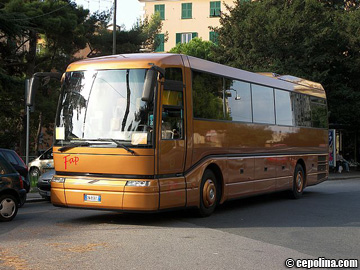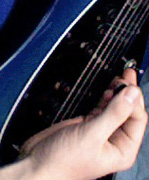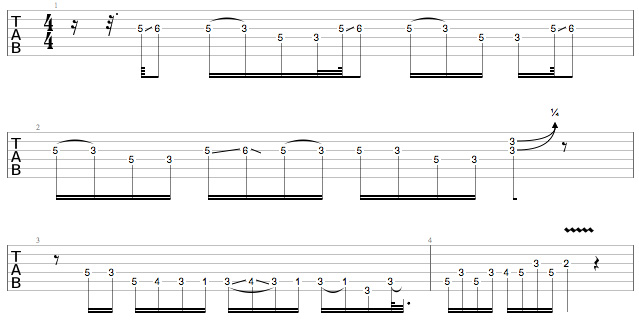I remember it perfectly.
It was 19 weeks ago that I arrived in Manhattan, guitar in hand, frantically looking for Chelsea Studios. Chelsea is one of the larger theatrical rehearsal studios in New York City and while I’d played in a number of pit orchestras before, I’d also never had any reason to find the place because I wasn’t an actor. Today was different.
Today I’d be meeting thirty other actors and musicians to depart for the national tour of the musical Cabaret. My contract was signed, I’d learned my parts and done my best to prepare for the next five months of my life on tour. I had suffered through a ‘disappointing’ tour experience the previous year playing guitar in a pit orchestra for Bye Bye Birdie with the same production company – the innumerable ten to twelve-hour daytime commutes, poor accommodations and frequent gear failures made for an utterly soul-crushing experience. I had hardened my resolve this time, however. This tour would be the greatest experience of my life.

One by one the cast and orchestra members trickled into the studio entrance. Actors in winter coats scurried in and out of the lobby doors trying to stay warm. Hellos and goodbyes were said, friends and family came and went and plenty of pictures were taken. Familiar faces, greetings and introductions got lost in a haze of giddy anticipation, and I became so eager to get out on the road that at one point I considered picking up my bags and just walking.
At long last the bus arrived, we loaded our luggage, and settled into our temporary home for a six-hour drive to Maryland. Somewhere around the Pennsylvania border it hit me:
Oh no, I’m trapped on a coach bus again.
Let’s fast-forward to the present:
I’m currently sitting in the hotel attached to the ‘John Ascuaga’s Nugget’ casino (perhaps one of the more unfortunate names for anything in recorded history), located just outside of Reno, Nevada. We’re in the middle of a ten-day run here which more or less ends our tour. Two weeks from today I’ll be on a plane headed back to the rocky coast of Maine. The trip has been alternately exhausting, rewarding, frustrating, depressing, incredible and consistently nothing that I’d expected.
I was fortunate enough to abandon the crowded coach that the cast traveled on for the slightly more relaxed travel schedule of the technical crew, by working as something affectionately known as a ‘Pit Rat.’ I traveled overnight and spent my days running cables and practicing. I had opportunities to see parts of the country that I never would have taken a chance to travel to… and I was paid to do it! I also ended up being the only jazz or rock musician in a group of orchestral players and dreaded playing the same score 120 times in a row. On top of that, I never found much in common with my fellow performers and I hit some pretty tough lows. What can you do?
At the outset of this tour, the good people at Guitar Messenger had asked me to write a tour blog, and while my work schedule here didn’t exactly permit that, I think I’ve been able to boil the tour experience down to a handful of things to consider before hitting the road. After talking to plenty of friends and fellow musicians who’ve toured in various capacities, I’ve put together a list that should hopefully cover anyone about to jump on a bus for the first time or climb into a used van with their friends. This will by no means cover all the bases, but should serve as a good jumping-off point for anyone about to embark on their first tour:
Itinerary

This is an easy way of saying: ‘Know what you’re getting yourself into.’ It’s pretty easy to be surprised by a long commute, miss a load-in time or realize that you don’t have time to eat before a gig. Try to keep a book with a page for each day including travel distances, estimated travel times, load-in and set times and so on. There’s nothing that makes a band look less professional than showing up late to load-in, missing soundcheck and so on. It also forces you to look realistically at the circumstances you’re traveling and living in. As I’m writing this, I’ve just received a text message from a friend saying: ‘Just drove from Brooklyn to Cleveland in a van with six other guys. This sucks.’ He did seem strangely optimistic about that living situation before he left, though. Funny…
Gear
Smaller is better. As tempting as it may be to bring your half-stack, pedalboards, six guitars, etc, your back, budget and van will thank you for going with a smaller amp and maybe one or two instruments, if possible. Nothing is worse than loading out a huge rig by yourself every night. Even more importantly, it makes room for…
Amenities
There are certain essentials that you’ll want to have while living in a van/bus/etc for an extended period of time: Toiletry kits, extra towels, a cooler for food (eating out every night can get very expensive very quickly, especially if you’re a relatively unknown band who may very well be losing money on your first tour for the sake of exposure), first-aid kit, etc. I’ve found that the two most important things for any traveling performer are Emergen-C and a laundry bag. You can always put your dirty clothes back in your suitcase, but you’ll be astounded by how quickly a small living space can start reeking with four or five only moderately smelly people living in it.
Space
Above all else, the most important thing you can possibly have on a tour. You’re about to live with and see the same people 24 hours a day every day almost without fail. Some careful diplomacy may occasionally be necessary, but if you establish some guidelines at the beginning of a trip, you’ll head off a lot of potentially tour-ending fights. No matter how much you like your bandmates, it seems like almost everyone leaves a tour wanting to maim someone. A good rule of thumb is to never subject anyone around you to anything that you yourself wouldn’t want to deal with. This includes mess, poor hygiene, loud headphones and pretty much anything else you might find to be a pet peeve. These issues can and do lead to massive fights when your entire life consists of dealing with the same half dozen people all day, everyday.
Etiquette
Since the goal of a first tour is to establish professional connections, win fans, etc, being friendly with everyone you encounter in the venue is key to having a successful tour. The rule we were given on the musical theatre tours is: ‘Realize you’re in someone else’s house and act accordingly.’ It’s a lot easier to whine about a terrible venue, poor sound system, show promotion and so on than anyone really realizes, and it’s even easier to have a negative reputation precede you if go around starting fights. Don’t be afraid to introduce yourself personally to the people running the door, the soundguy and any event staff you deal with, smile and say thank you. At the very least, remember this: Hell hath no fury like a technical staff scorned.
Diet

I cannot count the number of times I’ve gotten food poisoning or otherwise sick on the road from eating at greasy diners, consuming frozen cheeseburgers from truck stops, purchasing seafood in the middle of the Nevada desert and making any number of other terrible decisions. If you have the opportunity, go grocery shopping before you head out and pack some sort of cooler so you can eat a suitable diet.
Paying even a little attention to your nutritional needs will go a long way towards preventing illness on the road. Having a supply of Emergen-C on the bus/van/moped/pack-mule/etc can be a lifesaver. If you absolutely have to go the truck stop route, be aware that the batter on the corn dogs is only there to prevent you from seeing whether or not the hot dog inside is suitable for human consumption.
Show preparation
Warming up before playing becomes a little more important when you spend so much of your day sitting still in a vehicle or venue, and especially so when you’re performing every night. Much like eating right, finding a warm-up regimen that works for you can be crucial to avoiding injury with a rigorous performance schedule. I’ve played more than a few shows with ice packs awkwardly gaffe taped to my shoulders and seen plenty of bassists get hurt the same way – developing neck, back and shoudler problems from a combination of commutes and inadequate stretching. It’s an impossibly hard position to work yourself out of once you’re hurt, so it’s best not to tempt fate.
As I said before, this list is by no means a comprehensive guide. People’s tour experiences vary wildly and that’s really the beauty of traveling and performing in that capacity. Every day is different and sometimes fraught with surprises good and bad. Hopefully this guide will be enough to set you on the right path, and help ensure that – with the right precautions – your first time on the open road is a success. Good luck!

















